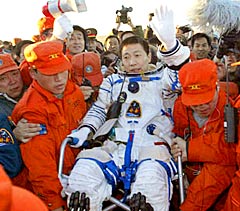
"Today, October 16, 2003, is a day that every Chinese is proud
of and is unforgettable. It is in this day that we Chinese make our
dream true to accomplish the first manned space mission entirely
relying on ourselves," said Mr. Xie Mingbao, director of the China
Manned Space Engineering Office, at a press conference organized by
the State Council Information Office at 10:30 am on October 16.
On the morning of October 16 (Beijing time), the Chinese-made
Shenzhou V spacecraft successfully accomplished its mission
including several scientific experiments after orbiting the earth
14 times, landing safely on the Amugulang grassland in Inner
Mongolia at 6:23 am.
The following is how its mission was accomplished, step by step,
as explained by Mr Xie at the press conference:
Astronaut Yang Liwei was finally chosen from a group of three
about 16 hours before the launch.
Two hours and 45 minutes before the launch, Yang Liwei began
putting on a special astronaut suit for working and living in space
and doing technical preparation.
At 5:55 am on the morning of October 15, Yang Liwei entered the
spacecraft.
587 seconds after lift off, the spacecraft separated from the
propelling rocket, ready to go into orbit. This position was very
close to the theoretical designated orbital position.
Flying around the earth by spacecraft needs about 90 minutes.
While flying in its fifth circle, Shenzhou V conducted an orbiting
shift, entering an oval orbit about 343 km away from the earth.
This was also very close with the designed point in orbit.
During the orbiting of the spacecraft, the ground command and
control center kept close touch with the astronaut. They got to
know some feature parameters including heart rate, blood pressure,
respiration and body temperature of the astronaut through remote
monitoring physical parameters, and observed activities, face
expressions and emotional changes of the astronaut through the
screen. Meanwhile, staff of the ground command and control center
and military leaders talked with the astronaut many times. The
astronaut kept close watch on conditions of the spacecraft in
implementing orders from the ground as well as his personal work
state.
During the orbiting of the spacecraft, the astronaut took many
pictures of the Earth using a digital camera and conducted extra
orders under direction of the ground command and control
center.
When the spacecraft was making its seventh circle round the
Earth, the astronaut displayed China's national flag as well as the
flag of the United Nations and completed other space
experiments.
From launch to return, the astronaut stayed in space for a total
of 21 hours and 23 minutes.
During its final orbiting, the land control center sent return
data to the spacecraft. When flying over southwest Africa, the
spacecraft began to execute return programs. Its first movement was
a 90-degree turn to separate the orbital module. Its second
movement was another 90-degree turn to make the rear forward, start
the brake engine, slow down and descend in height. When descending
to 145 km probably over Pakistan, the spacecraft separated its
propulsion module.
When entering the atmosphere at a height of 10 km, the
spacecraft opened a 1,200-square-meter parachute. When being only 1
meter to the ground, the spacecraft started four landing buffer
engines to land slowly like a hovercraft. The landing speed, about
2-3 meters per second like jumping from an elevated stand, didn't
hurt the astronaut at all. According to the report from the landing
area, the difference was only 4.8 km between the theoretical and
practical landing points.
When the re-entry module landed, the orbit module would still
stay in orbit to conduct scientific experiments.
Xie said, "We'll stick to the three-step development strategy
for manned space program approved by the Chinese government 10
years ago."
Following the successful mission of Shenzhou V, the next
objectives to be achieved include: space walking, precise docking
between spacecraft and orbit module, and the establishment of
spacelab.
"The realization of these objectives will promote China's manned
space technology to a higher level so as to make our due
contributions to the development and peaceful utilization of
space," said Xie.
(China.org.cn October 16, 2003)

